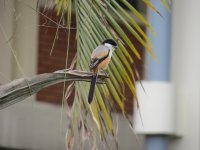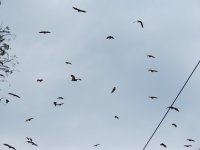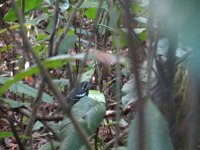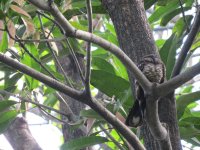simmojunior
Well-known member
2nd January At Sea
Today I had effectively burnt out and spent most the day catching up on sleep and attending some lectures. This meant I missed both Hourglass and Dusky Dolphins but no new birds.
The little seawatching I did do was relatively unproductive though it was nice to see some of the more northern species like Cook's Petrel again. In the evening, the boat anchored in the lee of Stewart Island. A lot of albatrosses gathered around the boat so we had some superb views of Buller's and Salvin's sitting on the water. We also saw a Stewart Island Shag and a New Zealand Fur Seal.
3rd January Arrival back on land
The brilliant voyage had to come to an end and I was looking forward to being back in civilisation where I could e-mail my parents and pick up messages.
As we disembarked early morning, I saw a Spotted Shag in the port and rather incongruously my only mainland Banded Dotterel flew over the coach as it was leaving the port.
Mark was driving to look for Rock Wren and, as this is what I was planning to do, we teamed up for a couple of days. We headed off to Te Anau, where I had booked to stay at the YHA, stopping at a small wetland. The weather was pretty grim and we were both very tired but we did manage to find Little Pied Shag, New Zealand Scaup and Australian Shoveler. I also saw my first New Zealand Yellowhammer from the car.
I did not do much the rest of the day except catch up on e-mails, messages and sleep. The next day was my last full day in New Zealand and we were heading to Milford Sound.
Today I had effectively burnt out and spent most the day catching up on sleep and attending some lectures. This meant I missed both Hourglass and Dusky Dolphins but no new birds.
The little seawatching I did do was relatively unproductive though it was nice to see some of the more northern species like Cook's Petrel again. In the evening, the boat anchored in the lee of Stewart Island. A lot of albatrosses gathered around the boat so we had some superb views of Buller's and Salvin's sitting on the water. We also saw a Stewart Island Shag and a New Zealand Fur Seal.
3rd January Arrival back on land
The brilliant voyage had to come to an end and I was looking forward to being back in civilisation where I could e-mail my parents and pick up messages.
As we disembarked early morning, I saw a Spotted Shag in the port and rather incongruously my only mainland Banded Dotterel flew over the coach as it was leaving the port.
Mark was driving to look for Rock Wren and, as this is what I was planning to do, we teamed up for a couple of days. We headed off to Te Anau, where I had booked to stay at the YHA, stopping at a small wetland. The weather was pretty grim and we were both very tired but we did manage to find Little Pied Shag, New Zealand Scaup and Australian Shoveler. I also saw my first New Zealand Yellowhammer from the car.
I did not do much the rest of the day except catch up on e-mails, messages and sleep. The next day was my last full day in New Zealand and we were heading to Milford Sound.
Last edited:








